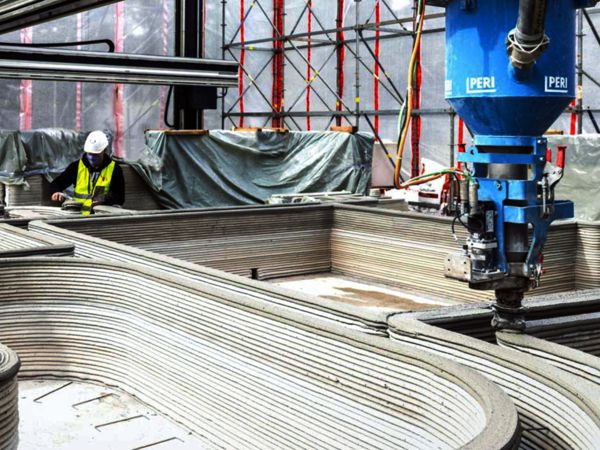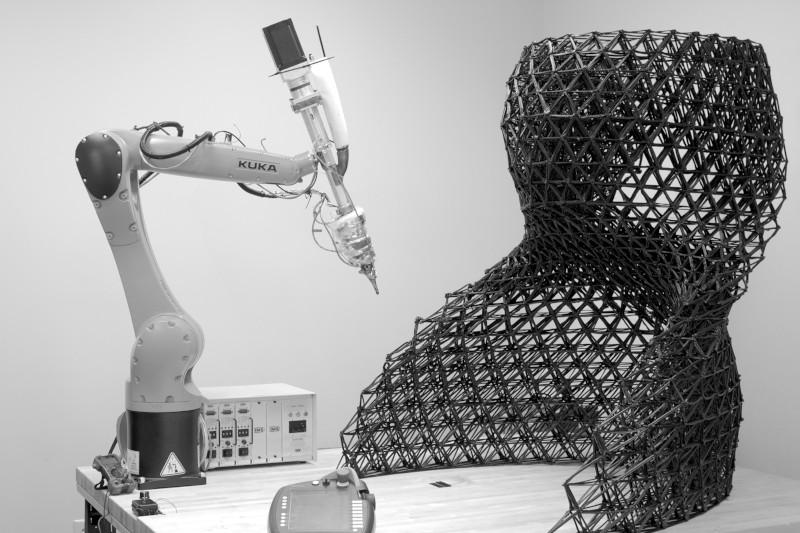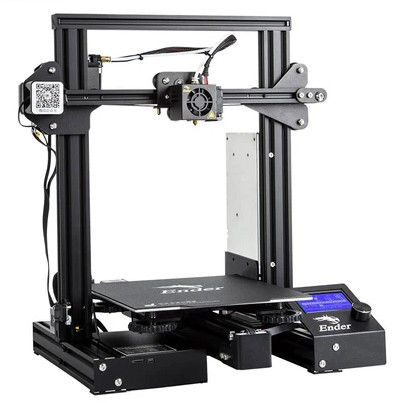3D Printed Home Construction Offers Promising Long-Term Outlook
Oct. 11, 2021
3D printing technology is progressing rapidly, offering significant cost and time savings relative to traditional construction methods.

3D printing in construction is moving from a cool concept to a practical reality quickly. Over the past several years many companies have invested millions of dollars into 3D printing research and development to revolutionize building construction.
As the construction industry faces higher building materials costs and tight labor markets, companies are looking for new and innovative ways to improve productivity and reduce material waste. 3D printing appears to offer a promising outlook as the technologies continue to improve.
What Is 3D Printing?
3D printing is an additive manufacturing process that makes three-dimensional (3D) solid objects. Similar to how you can print a Word document onto a piece of paper from a digital file on your computer, a 3D printer is able to print a three-dimensional shape from a computer drawing. Instead of applying ink to paper, a 3D printer "builds" up an object by printing material onto a base in successive layers until the final finished object is created.
3D printing is the opposite of subtractive manufacturing, which is similar to a CNC milling machine that removes or hollows out a larger piece of material such as metal, wood or plastic. 3D printing creates a much lower volume of waste material than traditional subtractive manufacturing.
3D printing is capable of creating shapes and designs that subtractive manufacturing cannot make because subtractive manufacturing requires holes and entry points to access areas to cut, while 3D printing can shape those areas as it creates the object. One such example is a complex solid lattice structure that would normally be very difficult for a milling machine to create.
Lattice structure created by Branch Technology

Source: Branch Technology
Most consumer household 3D printers create small objects by melting a plastic resin fed from a spool into a solid plastic resin object. The plastic is heated by an extruder at the tip of the printer nozzle, very similar to how a typical hot glue gun functions. The size of the object is limited by the height, width and depth of the printer frame.
Ender 3D printer, a popular consumer 3D printer

Source: Creality
More advanced 3D printers used in industrial applications are capable of using other materials, including metals high-performance plastics. Also, these advanced industrial printers often use lasers and other high-precision instruments to bond the material.
3D Printing Homes & Buildings
Over the past several years, many new construction startups and industry leaders have set their focus on delivering industrial-scale 3D printers to create homes, offices and other large structures. Experts believe that construction 3D printing will result in large cost savings and reduced cycle time.
3D printing homes is made possible by contour crafting, which uses a computer-controlled crane or gantry to build structures rapidly and efficiently with substantially less manual labor. Most construction 3D printers extrude a fluid-like cement material that hardens after a given amount of time.
The development of a cement-bound material for 3D printing is a major challenge. It should be easy to pump and extrude. It must also quickly develop sufficient load-bearing capacity so that the lower layers do not give out under the load of the upper layers. At the same time, the bond between the layers must be ensured.
- Dr. Jennifer Scheydt, Head of the Engineering & Innovation department at HeidelbergCement Germany
3D printed homes will make housing more affordable for billions of people worldwide because the cost of manufacturing a home is a step-change lower than traditional wooden frame homes. Also, 3D printed homes have better insulation properties because they use cement walls with air gaps.
ICON Built The First Permitted 3D-Printed Home In The USA
In 2018 ICON, a construction technology startup based in Austin, Texas, built the first permitted 3D printed home in the United States. The simple yet cost-effective 3D printed home was built using ICON's portable Vulcan printer. The 650 square foot home was printed in under 24 hours and cost less than $10,000.
Conventional construction methods have many baked-in drawbacks and problems that we’ve taken for granted for so long that we forgot how to imagine any alternative. With 3D printing, you not only have a continuous thermal envelope, high thermal mass, and near zero-waste, but you also have speed, a much broader design palette, next-level resiliency, and the possibility of a quantum leap in affordability. This isn’t 10% better, it’s 10 times better.
- Jason Ballard, Co-Founder of ICON
ICON's first 3D printed house in Austin, Texas


Source: iconbuild.com
Raw Earth 3D Printed Mud Homes
In 2021, Mario Cucinella Architects completed a sculptural home in the Italian city of Ravenna made entirely of 3D printed raw mud. The 645 square-foot TECLA home took about 200 hours to build.
The TECLA home, which gets its name by combining the words "technology" and "clay," is a step-change in 3D home printing technology because it used 100% locally sourced materials (raw earth) and no cement. Two printing arms (WASP Crane 3D printers) were synchronized and optimizing to print simultaneously and avoid colliding into each other.
TECLA's "circular housing" design provides structural support without the need for self-hardening materials like cement. The ability to source materials from the local terrain means that total greenhouse gas emissions are much lower than a comparable 3D printed home, and the home can be created almost anywhere in the world at a very low cost.
For this project, Mario Cucinella Architects not only explored housing solutions in formal aesthetic terms, it also studied the building’s shape in relation to its climate and latitude. In addition, the composition of the earth mixture responds to local climatic conditions and the filling of the envelope is parametrically optimized to balance thermal mass, insulation, and ventilation according to the climate’s needs. TECLA is a composition of two continuous elements that through a sinuous and uninterrupted sine curve culminate in two circular skylights that convey the ‘zenith of light.’
- Mario Cucinella Architects



Source: Mario Cucinella Architects
How A Home Is Printed
- A designer creates a 3D model of the home on a computer. The model can easily be resized and re-used.
- The 3D model is translated from a drawing into a set of instructions for the 3D printer. Instructions provide three-dimensional coordinates and movements to create the cement walls.
- The home's foundation is prepared by workers. Often this involves pouring a concrete base. At the moment, home foundations are not 3D printed, but this could change in the future.
- 3D home printer is erected at the construction site. The concrete mix is prepared and fed into the 3D printer.
- The printer starts printing. Workers are required to standby and assist if the 3D printer experiences an issue or needs help completing a gap (such as a door or window).
- Layers are stacked until the walls are formed. The process runs continuously.
- The concrete is allowed to dry and harden.
- Workers return to paint, add the roof, doors, and windows, and install electrical fixtures and plumbing.
3D Printed Homes Offer Promising Humanitarian Solutions
Global disasters such as hurricanes, earthquakes and tornadoes destroy thousands of homes every year around the world. Many families are left homeless for months, and it causes financial hardship. 3D printed homes could offer a cheap and efficient way to help rebuild and house displaced families in disaster zones.
3D printers themselves can be transported by cargo ships and reassembled at a construction site relatively quickly. In addition, most global regions have the basic materials needed to create the cement mixtures to print 3D homes.

Source: iconbuild.com
Every New Technology Improves Over Time
The current 3D printed homes will continue to evolve as we discover new and better materials and processes. Current issues include stress fractures (cracks in concrete walls), reducing the amount of human interaction to create gaps for windows and doors, building multiple floors, and testing resilience against natural disasters.
Some companies are experimenting with ways to create contraction joints (similar to the lines in sidewalks) to prevent stress fractures. Others are experimenting with different cement mixtures and wall designs to improve the way the cement is extruded and hardens.
Over time there will continue to be technological leaps that provide breakthroughs and improve the materials and processes. In time we could see entire communities of homes being built by 3D printers in a matter of weeks rather than months.
Resources
New Story + ICON : 3D Printed Homes for the Developing World



